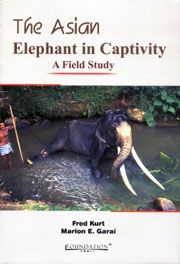Book contents
- Frontmatter
- Contents
- Preface
- Acknowledgments
- 1 Introduction
- 2 The Sri Lankan Elephant
- 3 The Captive Populations, Keeping Systems and Health
- 4 Food, Tool Use and Sleep
- 5 Musth, Reproduction, Social Integration and Stereotypy
- 6 Captive Elephants and Conservation
- 7 Base Lines and Proposals
- Appendix I
- Appendix II
- References
- Photo Gallery
- Index
5 - Musth, Reproduction, Social Integration and Stereotypy
Published online by Cambridge University Press: 05 February 2012
- Frontmatter
- Contents
- Preface
- Acknowledgments
- 1 Introduction
- 2 The Sri Lankan Elephant
- 3 The Captive Populations, Keeping Systems and Health
- 4 Food, Tool Use and Sleep
- 5 Musth, Reproduction, Social Integration and Stereotypy
- 6 Captive Elephants and Conservation
- 7 Base Lines and Proposals
- Appendix I
- Appendix II
- References
- Photo Gallery
- Index
Summary
Musth Bulls
Both the Asian and African elephants possess a skin gland in their temples, just above the cheekbone between the eye and external ear opening. This temporal gland is periodically active in males and females. In female Asian elephants temporal gland is active for a very short period of a few hours during mating and during parturition (Kurt, 1992). In adult Asian elephant bulls, musth is considered as a period during which testes and temporal gland are extremely enlarged (Chandrasekharan et al., 1992), testosterone level highly raised (e.g. Jainudeen et al., 1972; Cooper et al., 1990; Lincoln and Ratnasooriya, 1996), and sexual behaviour including regular masturbations, olfactory marking and aggression towards other bulls very pronounced (e.g. Kurt, 1974, 1992, 1995; Rasmussen and Schulte, 1998). The physiological changes during musth include blood acidosis, increased lipid catalysis and fluctuating, often greatly elevated serum, androgen and ketone concentrations. These alterations are characterised in the changed chemical compositions of breath, urine and secretions from the temporal gland (Rasmussen & Krishnamurthy, 2002). The chemical composition continually changes throughout the musth period. Musth is progressively assessed by increased amount of foul smelling, 2 nonanone. In young bulls the first musth periods are characterized by sporadic episodes of aggressive behaviour and fluctuating levels of serum testosterone and dihydrotestosterone, and the secretion of their temporal gland is composed of sweet smelling alcohols, ketones and esters (Rasmussen & Riddle, 2002).
- Type
- Chapter
- Information
- The Asian Elephant in CaptivityA Field Study, pp. 154 - 212Publisher: Foundation BooksPrint publication year: 2006

